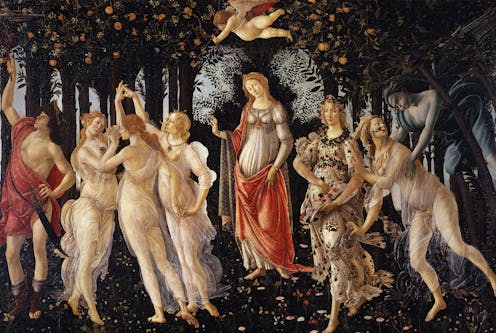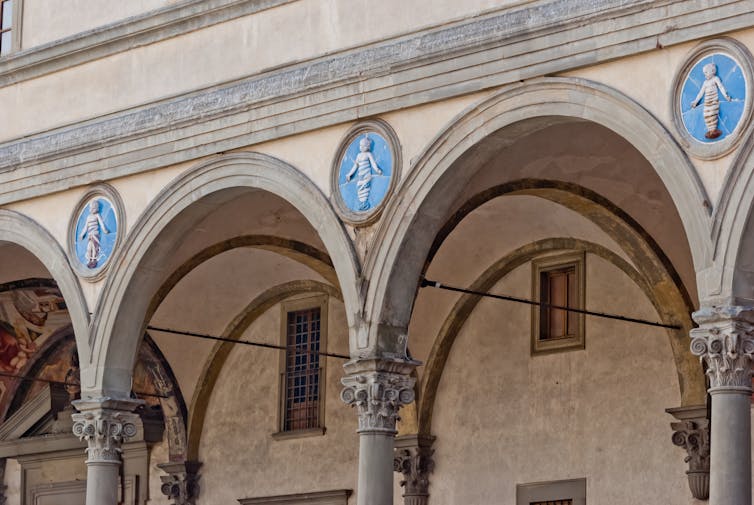
In Italy, abortion has been legal since 1978. But now that Giorgia Meloni’s Brothers of Italy party has won the national election and the far-right form a majority in both the Italian Parliament and Senate, access to abortion in Italy could face new restrictions.
Anti-abortion supporters like Movimento per la Vita have been buoyed by Meloni’s recent win as well as this summer’s United States Supreme Court ruling on Roe v. Wade.
As an art historian, my work has always seemed safely detached from today’s reality. However, after these recent political shifts, it seems historical artifacts and practices are now painfully relevant.
Revival from ages past
In Piazza di San Remigio, a few streets away from the Arno river in Florence, Italy, there’s a rectangular, box-like contraption encased in the wall about the same size as a bank machine. It sits opposite the façade of the church that gives the piazza its name. Drawings of sweetly swaddled babies are visible inside the box behind its glass pane.

The contraption is a culla per la vita or “cradle for life” where desperate mothers can deposit unwanted infants while retaining anonymity. Pressing a button opens the glass panel and the newborn can be placed inside the ventilated space on a receiving cloth. The partition closes automatically after ten seconds and cannot be reopened.
A sensor immediately notifies monitoring personnel and medical services who come to retrieve the infant.
This culla per la vita was installed in 2006 by the Florentine chapter of Movimento per la Vita, which aims to make abortions illegal in Italy. It is one of a growing national network of deposit points.
In the United States, there are over 100 baby boxes and, as in Italy, most are tied to anti-abortion, safe-haven movements.
No reproductive rights during the Renaissance
The mechanized “baby box” or “baby hatch” is a revival of centuries-old cultural practices — first recorded as early as the 12th century and which particularly flourished during the Italian Renaissance.
In 15th and 16th-century Italy women had no reproductive rights. Without access to advanced medical care, women used all kinds of methods to end unwanted pregnancies, such as time-honoured herbal abortifacients, acidic substances, the insertion of foreign objects and folkloric practices.
Regardless of whether the pregnancy was wanted or not, the risk of death during childbirth was inescapable across all social classes. Although historical maternal mortality rates are hard to calculate, one estimate, using Florentine Libri dei morti (Books of the Dead), concludes that at least one out of five women of childbearing age died due to neonatal complications and trauma.
It was not unheard of for women to write wills while pregnant, especially when carrying their first child. The risk of complications was amplified by the pubescent age of many Renaissance brides.
The ‘Primavera’ by Botticelli
In Florence today, visitors flock to the city’s historic Uffizi galleries to experience the beauty of Botticelli’s Primavera and other Renaissance artworks. But whether viewers of the painting realize it or not, Primavera draws attention to stark inequalities for women.
The painting, some argue, commemorates a marriage, possibly that between Lorenzo di Pierfrancesco de’ Medici and Semiramide Appiani in 1482. At the far right of the panel, the god Zephyr pursues the terrified nymph Chloris. Raped by Zephyr, Chloris transforms into the goddess Flora, who holds a cluster of blossoms at her abdomen, emphasizing her fertility, and to the eyes of a new bride, foreshadowing her expected pregnancies.
While new mothers of the elite were served sweetmeats and delicacies and given lavishly painted deschi di parto (birth trays) to celebrate the delivery of a child, most Italian women of the time experienced harrowing deprivation.
An early baby box
In 1419, Florence’s Silk Guild commissioned Filippo Brunelleschi to design the famed Ospedale degli Innocenti, which opened in 1445.
The building’s loggia, or portico, features semicircular arches made of soft grey pietra serena, ornamented with glazed terracotta roundels of swaddled infants by Andrea della Robbia inserted in 1487.

Unwanted newborns were initially left in the loggia in the pila — an elevated basin or pillar — followed by the finestra ferrata, a small gated window, with dimensions that restricted the age of those accepted. Later, infants entered via la ruota degli esposti (“wheel of the exposed” or “foundling wheel”) — the preferred method of surrender by the 16th century.
Read more: After a newborn was found in a recycling bin, a safe haven baby hatch may save lives
This cylindrical wooden device allowed the baby to be placed in an opening, rotated inwardly, and received inside. Infants often arrived wrapped with small talismans or a scrap with a scrawled name. Half a ribbon, a broken charm, pendant, or coin, these marks of recognition were left with the child hoping for future reconciliation. The mother or relative kept the other half as proof of the long-lost familial relationship.
Catholic doctrine barred burials
Infant deaths were not just an earthly tragedy. Catholic doctrine forbade the baptism of deceased infants. Unbaptized infants who died quickly after birth, were officially barred from burial in consecrated cemeteries and family chapels or tombs.
Midwives plunged unresponsive newborns into water or doused them with liquid in a desperate test for life. If revived, religious authorities allowed emergency baptisms by midwives or laypeople.
Thousands of unwanted infants nevertheless survived their births.
Ultimately, the compassionate retrieval of abandoned infants may be a well-intentioned outcome to a highly complicated dilemma. However, we cannot forget the systemic torment of the mother by a world that does not provide adequate healthcare.
Will abortion rights change under Meloni?

Despite the legality of abortion many Italian women struggle to obtain one. Almost 70 per cent of gynecologists — 83 per cent in Italy’s southern regions — are conscientious objectors.
Giorgia Meloni has said that abolishing Italy’s abortion law is not on her agenda but her party has been accused of impeding abortion access in some regions. For example, Marche’s regional council opposes abortions using pill RU 486 in clinics outside hospitals in contrast to Ministry of Health guidelines.
Meloni has said she wants women “to have the right to make a different choice” other than abortion. The precise meaning of this statement is yet to be seen.
Heather Coffey does not work for, consult, own shares in or receive funding from any company or organisation that would benefit from this article, and has disclosed no relevant affiliations beyond their academic appointment.
This article was originally published on The Conversation. Read the original article.







